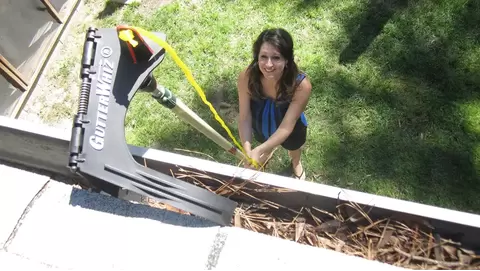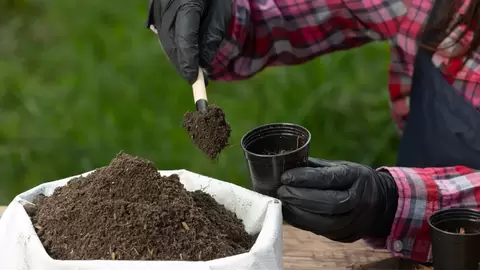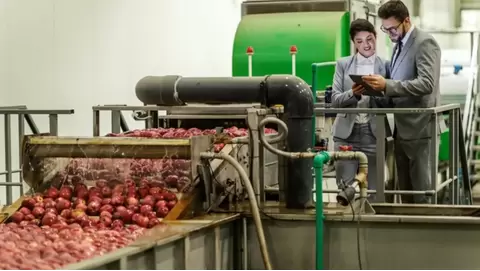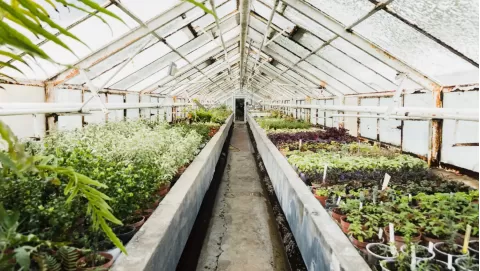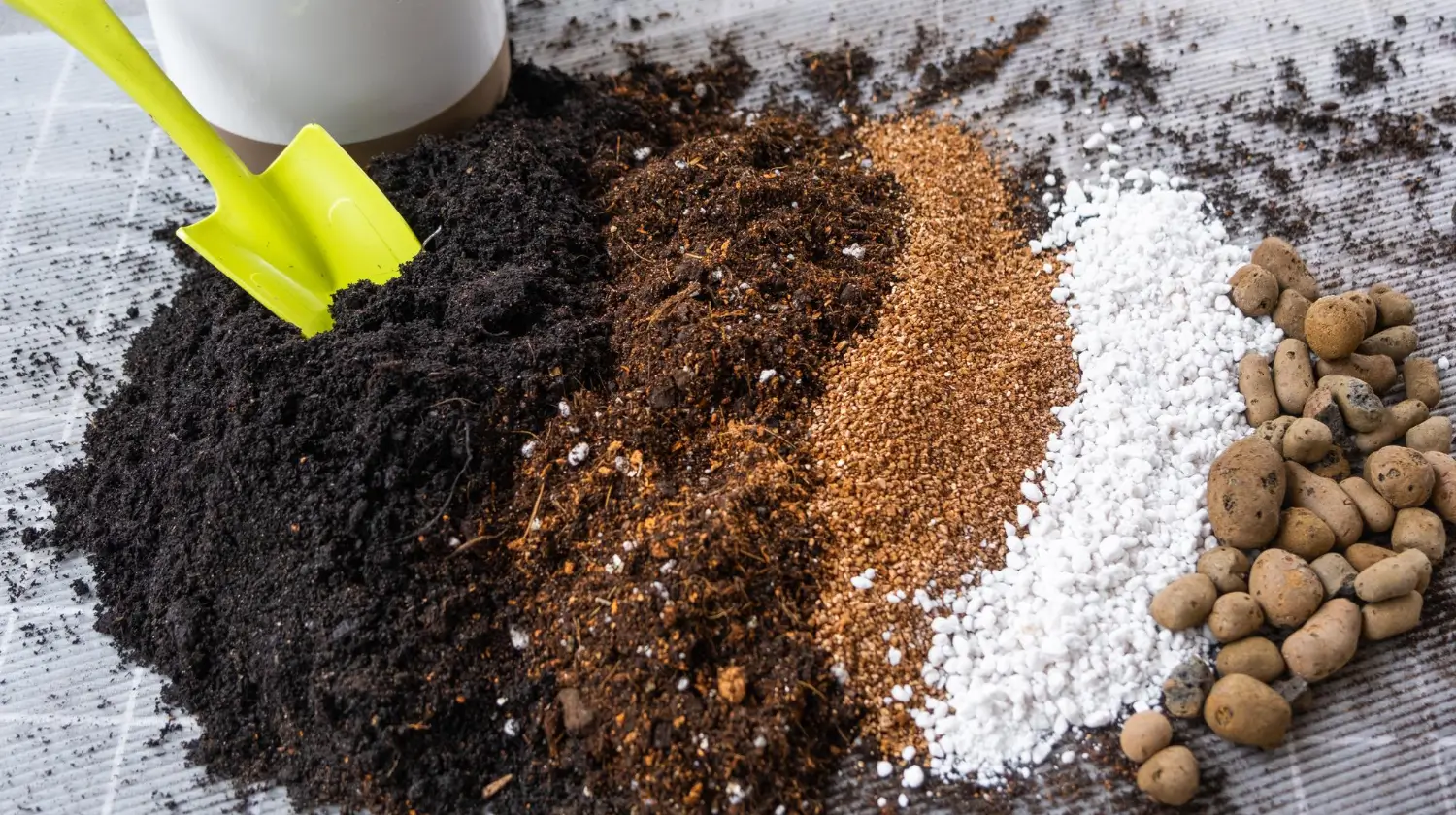
Top Soil Amendments to Boost Plant Growth
The key to a healthy garden is healthy soil. Healthy soil can more effectively supply nutrients to plants, making the plants and the garden healthier. Soil is important for keeping plants nourished, but poor soil can limit the nutrients available to plants. In such cases, soil amendments become necessary.
- What: Soil amendments enhance soil properties to support plant health and growth.
- Common Types: Compost, manure, peat moss, vermiculite, and biochar.
- Purpose: Improve soil fertility, texture, water retention, and nutrient availability.
- Benefits: Enhanced root development, better aeration, and increased crop yields.
- Application: Mix into garden beds, containers, or lawns during soil preparation or throughout the growing season.
- Pro Tip: Conduct a soil test before choosing amendments to address specific deficiencies.
Soil amendments are materials added to the soil to improve its condition and help plants grow better. They aim to create a better environment for roots to develop. Soil amendments can be organic, like compost, or inorganic, providing specific nutrients based on the plants' needs.
Growcycle offers a variety of soil amendments to help gardens thrive. This article will explain everything about soil amendments and highlight popular options for healthier, more productive plants.
What Are Soil Amendments?
A soil amendment is any substance that can improve the physical characteristics of soil, including drainage, aeration, structure, permeability, water infiltration, and water retention. Some soil amendments add nutrients, aid in moisture retention, and help maintain proper pH balance. All these changes result in a healthier and vibrant garden or lawn.
Soil amendments are a great way to transform a garden or lawn. The following are the main categories of soil amendments.
Organic Soil Amendments
Organic soil amendments come from natural sources. They improve soil organic matter content and provide numerous advantages. Although numerous organic amendments are available, the most common is compost. Organic matter promotes soil aeration, water infiltration, and water and nutrient retention capacity over time.
Many organic amendments include plant nutrients and function as organic slow-release fertilizers. Organic matter also serves as a food supply for soil-dwelling bacteria, fungi, and invertebrates.
Inorganic Soil Amendments
Inorganic soil amendments are specifically designed to meet the needs of specific plants. Homeowners or gardeners may often use them for specialty growing plants tailored to the type of garden being designed and planted.
Inorganic soil amendments usually benefit rock and crevice gardens, cactus gardens, and sites heavily impacted by foot or vehicular traffic.
Types of Organic Soil Amendments
Organic soil amendments are natural ways to meet plants' nutritional and other requirements. Here are the common types of organic soil amendments.
1. Compost
Compost is a versatile soil amendment for organic vegetable gardens, lawns, and ornamental beds. It is packed with many vitamins and minerals that plants require, helping plants grow more quickly, produce more in the harvest, and become naturally resistant to pests and diseases.
Compost can help to reduce compacted or poorly draining soil, increase beneficial microbial and earthworm activity, and improve soil health and structure. For natural weed control, compost can be applied as mulch and a top dressing to garden beds. Moreover, compost is among the least expensive soil additives available.
2. Manure
Manure is among the best soil amendments for all purposes. It is abundant in the nutrients plants require, can improve the soil's porosity and structure, and increases the activity of helpful microbes.
Gardeners can apply fresh manure directly on the soil or apply compost beforehand, but be aware that certain fresh manures can burn plant tissue. So, gardeners should only use fresh manure in their gardens in the fall following plant harvest.
3. Blood Meal
Blood Meal is one of the best sources of nitrogen for plants. Nitrogen plays an essential role in photosynthesis and keeping the plants green. After mixing it into the soil, blood meal encourages lush, vegetative growth and beautiful leafy greens. It is particularly suitable for producing maize, with an NPK ratio of 12-0-0 to 13-0-0.
In addition to its fertilizer use, blood meal is commonly used as a pest deterrent to keep rabbits and deer away from the area because they are afraid of the stench. Homeowners can till 3 to 5 pounds of blood meal per 100 square feet of garden soil. It can also be sprinkled on plants or used as a side dressing to keep pests away from plants.
4. Feather Meal
Feather meal is another animal-based soil amendment that functions similarly to blood meal. It is a high-nitrogen fertilizer with an NPK ratio of 13-0-0 and is absorbed by garden soil quickly, so it is the best alternative to feather meal.
Since feather meal is not water-soluble like blood, gardeners must mix it into their soil before planting. Because of its high nitrogen content, feather meal is perfect for heavy feeders like:
- Corn
- Melons
- Brassicas
5. Bone Meal
Bone Meal has an NPK ratio of 4-12-0 and is a rich source of phosphorous and nitrogen. It is among the most outstanding options for large flowers and robust root growth. Therefore, it's no surprise that gardeners frequently add bone meal to the planting holes while planting carrot seeds and other root crops.
In addition to being high in calcium, bone meal can help to prevent problems like blossom end rot. Gardeners may need to reapply it on the soil because it is a slow-release fertilizer that may take up to four months to absorb fully. Additionally, bone meal is occasionally sprinkled in the holes when planting bulbs.
6. Alfalfa Meal
Alfalfa Meal is another excellent soil amendment. It is high in potassium and nitrogen, with an NPK ratio of 2.8-0.5-3.6. It is a popular choice for vegan farmers and can frequently be purchased in large quantities to minimize costs. Although animal fertilizers can smell unpleasant, the Alfalfa meal is a top choice for being one of the best-smelling amendments available.
Additionally, its smell is far less likely to draw predators who will plow through the garden for blood or bone meal. The best way to apply alfalfa meal is to use two to three pounds per 100 square feet of growing space.
7. Kelp Meal
Kelp Meal is another nutrient-rich organic soil amendment with an NPK ratio of 1.0-0.1-2.0. Its main advantage is that it is a rich source of:
- Enzymes
- Amino acids
- Trace minerals
All these compounds can assist plants in growing more robustly and improving the nutrient content of food crops to ensure healthier vegetables and fruits.
Kelp meal, made from dried and pulverized seaweed, is especially beneficial for soil low in sulfur or boron. Brassicas, such as cauliflower and Brussels sprouts, enjoy kelp food. The best way to apply kelp meal is to pour 1 pound per 100 square feet of garden space.
Types of Inorganic Soil Amendments
Inorganic soil amendments are mineral-based or manufactured materials to improve soil quality or provide specific nutrients for plants. Here are the main types:
1. Lime
Lime is a soil amendment made from ground limestone rock, which naturally consists of calcium and magnesium carbonate. When lime is added to soil, these compounds increase the soil's pH, making it less acidic and more alkaline. Even though lime contains calcium and magnesium necessary for good plant growth, it is not a substitute for fertilizer. Its principal function is to change soil pH and offset soil acidity, improving plant nutrient availability.
Lime is necessary for lawns when low soil pH limits nutrient availability. Warm-season grasses may tolerate a slightly lower pH, but cool-season grasses prefer a slightly higher pH. Even abundant nutrients are limited when the pH strays too far in either direction. Lime restores equilibrium in too-acidic soil, returning pH to appropriate growing levels.
2. Gypsum
Gypsum is another inorganic sulfate mineral used by gardeners as fertilizer or produced as powder and added to concrete and plaster. Different impurities and other inclusions can give gypsum minerals different colors, such as:
- White
- Gray
- Pink
- Brown
- Green
Gypsum helps boost plant nutritional requirements, improve soil structure, balance pH, and lower aluminum toxicity. Shops typically sell gypsum for gardening as pellets or granules, either white, gray, or brown.
3. Perlite
Perlite is made from amorphous volcanic glass and is often used in gardening to amend soil. Its soil is mixed into potting and plant beds to increase aeration and drainage, avoid soil compaction, and encourage healthy root development. Its lightweight design and water-retention capabilities are excellent for container gardening and potted plants.
Using equal parts perlite, peat moss, or coco coir, gardeners can improve moisture retention and avoid root rot and other fungal diseases. This promotes overall healthy plant growth.
4. Claying
Claying is the process of adding clay rich subsoil into water-resistant topsoil to overcome the water-repellent soil restriction. Clay can decrease soil water repellency, including long-term impact, improve soil water retention, reduce wind erosion, decrease the risk of frost, improve soil organic carbon, and improve soil structure and plant establishment.
Moreover, claying can help sandy textured topsoils with less than 5% clay concentration, where water repellence is a barrier to crop and pasture growth.
5. Vermiculite
Vermiculite is a mica-like material used as a soil amendment. It is extracted from the earth, exfoliated, and processed with tremendous heat and pressure. The resulting worm-like, curled, and sterile product can grow. Its capacity to expand allows it to retain moisture in the soil, while its porous surface and distinctive shape capture nutrients for plants to use as needed.
Vermiculite lightens thick soils, creating a better environment for plant roots. Additionally, vermiculite is sterile, so gardeners don't have to worry about hazardous plant infections.
Benefits of Soil Amendments
Soil amendments offer several benefits that improve soil health and plant growth. Here are the main advantages:
- Lawn Aeration and Compost Application: Compacted soil and a thick thatch layer prevent healthy root growth before aeration. After aeration, holes allow water, oxygen, and compost to penetrate the soil. Over 8–10 weeks, this improves root depth, strengthens grass, and creates a denser, healthier lawn.
- Boost Plant Growth: Organic soil amendments improve plant development and crop output.
- Improve Soil Nutrients: Organic soil additives include plant nutrients. However, due to their low nutritional content, they are not typically called fertilizers.
- Increase Drainage: Using clay on soil improves fine-textured soil by increasing soil pore space, which improves soil aeration, infiltration, and drainage.
- Decrease Water Use: Organic soil additives improve coarse-textured soils by boosting their water and nutrient retention capacity.
- Improve Soil Structure: Soil amendments, especially organic ones, fuel bacteria, fungi, and microbes that bind soil particles and improve their physical structure.
- Improve Plant Health: Organic soil amendments help to combat plant diseases.
- Decrease Air Pollution: Using local soil amendments can reduce the consumption of fossil fuels and air pollution compared to shipping materials nationwide.
- Balance pH: Soil amendments, primarily inorganic ones, can help maintain soil pH.
- Maintain Salt Content: For soil or water with high salt concentration, applying soil additives with low conductivity (around 3.0 or lower) is very helpful in maintaining salt content.
- Cost-effective: Compost or manure can be readily available at home so that soil amendments can work in a reasonable range.
Things to Consider While Choosing a Soil Amendment
Choosing the right soil amendment is important for improving soil health and supporting plant growth. Here are key things to consider:
Check the Soil’s pH
Soil pH shows if the soil is acidic, neutral, or alkaline. Plants grow best when the pH matches their needs. If the soil is too acidic, lime can raise the pH. If it is too alkaline, sulfur can lower it. Testing the pH helps make the right choice.
Think About the Purpose
Different amendments solve different problems. For example, compost improves overall soil structure, while perlite helps with drainage. Knowing whether the goal is to fix drainage, hold more water, or add nutrients will guide the choice of amendment.
Match the Plants’ Needs
Each type of plant has specific needs. Some plants grow better in acidic soil, while others prefer alkaline soil. Choosing the right amendment for the grown plants ensures they get the best environment to thrive.
Choose Between Organic and Inorganic
Organic amendments like compost or manure improve soil over time and add organic matter. Inorganic options like gypsum or synthetic fertilizers work faster but may need more frequent use. Picking between these depends on the desired speed of results and long-term goals.
Think About Long-Term Effects
Organic amendments improve soil slowly but provide lasting benefits. In contrast, inorganic amendments act quickly but may need to be applied more often. Choosing the right type depends on whether the focus is short-term fixes or long-term improvement.
Consider Environmental Impact
It is important to pick amendments that are safe for the environment. Organic options are usually eco-friendly, while excessive use of synthetic fertilizers can harm soil and water. Choosing wisely helps protect the environment.
Budget and Availability
Cost and availability also matter when selecting an amendment. Many organic options, like compost, can be made at home for free. For other types, it's best to choose something affordable and easy to find.
Best Practices to Apply Soil Amendment to Garden
The following are the steps that a gardener must follow to apply soil amendment to a garden:
1. Test the Soil First
Testing the soil is essential before adding any amendments. A soil test helps determine the pH, nutrient levels, and soil type. This information ensures the right amendment is chosen and applied in the correct amount.
2. Choose the Right Amendment
Select an amendment that matches the garden’s specific needs. Compost is great for improving soil structure, while lime adjusts pH. The choice depends on the plants being grown and the condition of the soil.
3. Prepare the Soil
Loosen the soil by digging or tilling before applying amendments. This allows the material to mix well and reach plant roots more effectively. Remove any weeds, rocks, or debris to ensure the soil is ready for improvement.
4. Follow Recommended Application Rates
Use the recommended amount of soil amendment based on the product instructions or soil test results. Overusing amendments can harm plants and soil, while using too little may not be effective.
5. Apply Evenly
Spread the amendment evenly across the garden. For smaller areas, use a shovel or hand tools. For larger gardens, consider using a spreader. Mixing the amendment thoroughly into the soil ensures it works well.
6. Water After Application
Water the area lightly after applying and mixing the amendment into the soil. This helps the material settle into the soil and activates nutrients, making them available for plants.
7. Apply at the Right Time
The best time to apply amendments is before planting, either in early spring or late fall. This allows the soil to improve and prepare for the next growing season. For existing plants, apply amendments carefully around the root zone.
8. Monitor and Adjust
After applying the amendment, observe the plants and soil. If plants show signs of stress or poor growth, adjust the type or amount of amendment during the next application. Regular soil testing can help fine-tune the process.
Common Mistakes to Avoid while Applying Soil Amendments
The following are some common mistakes that a gardener should avoid while applying soil amendments to soil:
- Applying amendments without knowing the soil requirements can lead to harmful consequences. Therefore, a gardener should conduct a test to see the soil pH and other requirements.
- Too much organic or inorganic matter can disrupt soil microbial activity and pollute runoff. Therefore, homeowners should avoid over-applying soil amendments.
- Gardeners may misapply soil amendments, leading to nutrient washout. So, it is better to use soil amendments during the early spring or fall.
- Inappropriate application of soil amendments or leaving some space while applying soil amendments doesn’t give the desired outcomes. Therefore, gardeners should spread the amendment thoroughly on the soil.
- Too much synthetic or inorganic soil amendment, such as peat moss, can contribute to environmental degradation. Therefore, gardeners should use organic matter more than chemicals for soil amendments.
FAQs
What are the best soil amendments?
The best soil amendment depends on the soil requirements. Compost is best for organic matter; gypsum is best for clay soil; lime to maintain soil pH; and biochar to increase nutrient retention. All these options are best to improve overall pants growth.
What is the topsoil amendment?
Topsoil amendments are additives applied to or blended into the topsoil to alter soil qualities and boost plant development. Compost boosts soil structure, and lime boosts soil pH.
What is the best thing to mix with topsoil?
Organic matter like compost, sand, blood, or bone meal is best to mix with topsoil. Compost increases the soil's nutrient content, while blood or bone meal improves water retention and the soil's overall physical properties, leading to a healthy garden.
The Bottom Line
Soil amendments are the best way to boost plant growth by improving nutrient content, water retention, and microbial activity. Gardeners can use organic or inorganic soil amendments to meet soil requirements and achieve a healthier, lush garden or lawn. However, choosing the right application timing and amendment amount is key to a healthier, evergreen garden.
Growcycle offers the best soil amendment options, including inorganic and organic plant nutrients to meet the nutritional requirements of soil and plants. Growers can buy soil amendments from their marketplace to have a lively garden.
Disclaimer: This material is for informational purposes only and should not be relied on for legal, medical, financial, or any other form of professional advice.




